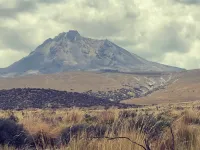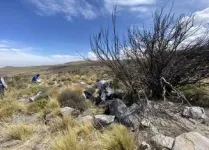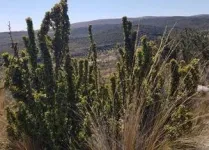(Press-News.org) In September 2018, a wildfire burned nearly two thousand hectares of shrubland on the Pichu Pichu volcano, an ecologically significant area in the Peruvian Andes. Unlike Mediterranean ecosystems, where vegetation has evolved strategies to withstand fire, the volcanic soils of Arequipa—one of the driest regions in the world—are not adapted to wildfire disturbances. A Miguel Hernández University of Elche (UMH) research team collected and analyzed soil samples from the burned area at 3,700 meters above sea level to understand how these fragile ecosystems respond to fire disturbances.
The results, published in the Spanish Journal of Soil Science, indicate that four years after the fire, vegetation and soil combustion, combined with post-fire erosion, have caused a severe loss of soil organic carbon (SOC)—a key element for soil fertility. “The Peruvian Andes are not prepared for wildfires,” warns UMH professor Jorge Mataix Solera, a scientist with more than thirty years of experience studying post-fire soil recovery. Mataix emphasizes that fire is a natural ecological force, but its effects vary significantly depending on the ecosystem. The study’s findings indicate that Pichu Pichu’s soil has undergone significant physical and chemical degradation after the fire, hindering ecosystem recovery. Furthermore, post-fire erosion has triggered additional degradation, reduced clay content, and weakened soil structure.
Post-Fire Water Repellency and Soil Vulnerability
One of the challenges identified in these arid soils is their natural tendency to repel water, a phenomenon influenced by organic matter characteristics and high sand content. This water repellency persisted after the fire, exacerbating erosion. Without vegetation to retain moisture, water runs off the surface rather than infiltrating the soil, accelerating erosion. “While well-structured and evolved soils, such as Mediterranean soils, have a high water-holding capacity, young volcanic Andean soils, which are naturally sandy, lose this ability after fire-induced organic matter loss,” explains UMH researcher Minerva García Carmona.
“This is why understanding the effects of fire on these young and fragile soils is crucial,” García adds, “especially considering the role of plants, which form the combustible material in wildfires and influence soil degradation.”
Key Plant Species and Their Influence on Post-Fire Soil Degradation
The study focused on two native plant species with a critical role in the ecosystem: Berberis lutea, known as "palo amarillo del Perú," and Parastrephia quadrangularis, or "tola." Researchers examined whether fire had different effects on soils depending on the dominant vegetation. The results revealed that areas dominated by Berberis lutea experienced greater soil degradation. “This is likely because it is a larger plant with higher biomass, which intensified combustion effects,” García clarifies.
The UMH research team has extensive experience studying wildfire impacts on Mediterranean forests, which have developed resilience strategies due to their long history of fire exposure. However, their findings in Pichu Pichu confirm that volcanic soils in Arequipa naturally retain less water and are particularly vulnerable to fire degradation. This highlights the increasing threat wildfires pose to these ecosystems.
A Fragile Ecosystem in the Andean Volcanic Belt
Pichu Pichu is located in the central volcanic zone of the Andes. UMH researchers collected soil samples at approximately 3,700 meters above sea level, where annual precipitation averages just 385 mm, concentrated over three to four months. This makes the Arequipa region a "cold desert," with temperatures ranging from 4 to 18°C. The vegetation consists mainly of highly drought-adapted shrubland.
Due to limited precipitation, the Andean Volcanic Belt is a crucial water source for surrounding areas. “Although Pichu Pichu is dominated by shrubland, its foothills support forests that host a rich diversity of plant and animal species,” explains a UMH professor. These foothills include queñua forests (Polylepis), whose endemic species in Peru are currently endangered.
The Rise of Wildfires in Peru and Climate Change Implications
In Peru, most wildfires occur between July and October. In September 2024, the satellite monitoring project Queimadas recorded an all-time high of 7,037 wildfire hotspots in the country. “In a region like Arequipa, located in a desert environment, understanding soil response under new fire regimes is essential for assessing ecosystem resilience to climate change,” explains a UMH researcher.
Mataix believes that the more we learn, the better we can help design prevention strategies and post-fire treatments to mitigate the effects of rising temperatures and intensified droughts. “This is as crucial in Peru as it is in Spain or California,” Mataix concludes. “Although fire is a natural phenomenon, the climate crisis is exacerbating these events, and we must do everything possible to restore and protect these ecosystems.”
END
Wildfires in the Andes cause severe soil degradation and hinder ecosystem recovery
A new study reveals the extreme vulnerability to wildfires of one of the planet's most arid regions: the Arequipa shrublands of Pichu Pichu, in the Andean Mountain range of Peru.
2025-02-17
ELSE PRESS RELEASES FROM THIS DATE:
Men and boys matter: Psychology professor reveals hidden issues we need to talk about
2025-02-17
These include those linked to body image, fatherhood and sexual relationships. His latest book - Current Issues Facing Men and Boys – also argues that men struggle to negotiate harmful notions of masculinity and are not included in conversations around gender.
Current Issues Facing Men and Boys urges the public, policymakers, practitioners and other key stakeholders to explore and support policies and practices that promote male wellbeing. This book comes as the UK government announces plans for the country's first men's health strategy, aiming ...
1 in 6 parents support teens getting non-surgical cosmetic procedures with parental consent
2025-02-17
For teens who may be self-conscious about issues such as acne scarring or discolored teeth, non-surgical cosmetic procedures are an increasingly popular way to address their concerns.
And some parents are supportive of this decision, a national poll suggests, with a sixth saying teenagers should be allowed to receive these types of aesthetic treatments for any reason as long as they have parental approval.
But half of parents only support teens getting non-surgical cosmetic procedures if there’s a valid reason – and their beliefs about which reasons count as valid differ – according to ...
Journalist travel grants available for 12th Heidelberg Laureate Forum
2025-02-17
This September, recipients of the Abel Prize, ACM A.M. Turing Award, ACM Prize in Computing, Fields Medal, IMU Abacus Medal and the Nevanlinna Prize are invited to gather in Heidelberg to meet with 200 young researchers from all over the world at the 12th Heidelberg Laureate Forum (HLF). In order to reach a broader, more diverse and international audience, the Heidelberg Laureate Forum Foundation (HLFF) encourages journalists to cover the event and affords them the chance to interact with the preeminent scientists of mathematics and computer science. The 12th HLF will take ...
Are we still primitive? How ancient survival instincts shape modern power struggles
2025-02-17
The evolutionary roots of human dominance and aggression remain central to social and political behaviour, and without conscious intervention these primal survival drives will continue to fuel inequality and division.
These are the arguments of a medical professor who, as global conflicts rise and democracies face growing challenges, says understanding how dominance and tribal instincts fuel division is more critical than ever.
In A New Approach to Human Social Evolution, Professor Jorge A. Colombo MD, PhD explores neuroscience, anthropology, and behavioural science to provide a new perspective on human social evolution.
He argues that fundamental behavioural drives ...
Near-complete skull discovery reveals ‘top apex’, leopard-sized “fearsome” carnivore
2025-02-17
A rare discovery of a nearly complete skull in the Egyptian desert has led scientists to the “dream” revelation of a new 30-million-year-old species of the ancient apex predatory carnivore, Hyaenodonta.
Bearing sharp teeth and powerful jaw muscles, suggesting a strong bite, the newly-identified ‘Bastetodon’ was a leopard-sized “fearsome” mammal. It would have been at the top of all carnivores and the food chain when our own monkey-like ancestors were evolving.
Findings, published in the peer-reviewed Journal of Vertebrate Paleontology, detail ...
Reintroducing wolves to Scottish Highlands could help address climate emergency
2025-02-17
University of Leeds news
Embargoed until 05:01 GMT, 17 February
Reintroducing wolves to the Scottish Highlands could lead to an expansion of native woodland which could take in and store one million tonnes of CO2 annually, according to a new study led by researchers at the University of Leeds.
The team modelled the potential impact that wolves could have in four areas classified as Scottish Wild Land, where the eating of tree saplings by growing red deer populations is suppressing natural regeneration of trees and woodland.
They used a predator–prey model to ...
New antibody discovery platform can inform Alzheimer's and Parkinson's
2025-02-15
ROCKVILLE, MD – In diseases like Parkinson's and Alzheimer's, specific proteins misfold and clump together, forming toxic aggregates that damage brain cells. The process of proteins spontaneously clumping is called protein aggregation and researchers have developed novel methods to generate aggregate-specific antibodies as specific probes or modulators of the aggregation process.
This new method overcomes significant challenges in characterizing these complex and often transient protein structures. The work will be presented at the 69th Biophysical ...
The Biophysical Journal names Marcel P. Goldchen-Ohm the 2024 Paper of the Year-Early Career Investigator awardee
2025-02-15
ROCKVILLE, MD – Marcel P. Goldschen-Ohm, of the University of Texas at Austin, USA will be honored as the recipient of the Biophysical Journal Paper of the Year-Early Career Investigator Award at the 69th Annual Meeting of the Biophysical Society, held February 15-19 in Los Angeles, California. This award recognizes the work of outstanding early career investigators in biophysics. The winning paper is titled “GABAA Receptor Subunit M2-M3 Linkers Have Asymmetric Roles in Pore Gating and Diazepam Modulation.” The paper was published in Volume 123, Issue 14 of Biophysical Journal.
GABAA receptors mediate inhibitory synaptic signaling ...
A new system to study phytoplankton: Crucial species for planet Earth
2025-02-15
ROCKVILLE, MD – Phytoplankton, tiny plant-like organisms in the ocean, are incredibly important for life on Earth. They're a major food source for many sea creatures and produce almost half the oxygen we breathe. They also help control the climate by soaking up a lot of carbon dioxide, a gas that contributes to global warming.
Scientists want to learn more about how these phytoplankton use sunlight to make energy and oxygen, which can be useful in the context of environmental monitoring during ...
Scientists discover "genetic weak spot" in endangered Italian bear population
2025-02-15
ROCKVILLE, MD – The Apennine brown bear, also known as the Marsican brown bear (Ursus arctos marsicanus), is a unique and critically endangered subspecies of brown bear found only in the remote and rugged Apennine Mountains of central Italy.
A new study by the Italian Endemixit project (endemixit.com) reveals a potentially critical genetic flaw in the endangered Apennine brown bear population of Italy, offering insights that could help boost conservation efforts. The work will be presented at the 69th Biophysical Society Annual Meeting, to be held February 15 - 19, 2025 in Los Angeles.
This distinct population has been isolated for centuries, evolving unique physical ...
LAST 30 PRESS RELEASES:
Making lighter work of calculating fluid and heat flow
Normalizing blood sugar can halve heart attack risk
Lowering blood sugar cuts heart attack risk in people with prediabetes
Study links genetic variants to risk of blinding eye disease in premature infants
Non-opioid ‘pain sponge’ therapy halts cartilage degeneration and relieves chronic pain
AI can pick up cultural values by mimicking how kids learn
China’s ecological redlines offer fast track to 30 x 30 global conservation goal
Invisible indoor threats: emerging household contaminants and their growing risks to human health
Adding antibody treatment to chemo boosts outcomes for children with rare cancer
Germline pathogenic variants among women without a history of breast cancer
Tanning beds triple melanoma risk, potentially causing broad DNA damage
Unique bond identified as key to viral infection speed
Indoor tanning makes youthful skin much older on a genetic level
Mouse model sheds new light on the causes and potential solutions to human GI problems linked to muscular dystrophy
The Journal of Nuclear Medicine ahead-of-print tip sheet: December 12, 2025
Smarter tools for peering into the microscopic world
Applications open for funding to conduct research in the Kinsey Institute archives
Global measure underestimates the severity of food insecurity
Child survivors of critical illness are missing out on timely follow up care
Risk-based vs annual breast cancer screening / the WISDOM randomized clinical trial
University of Toronto launches Electric Vehicle Innovation Ontario to accelerate advanced EV technologies and build Canada’s innovation advantage
Early relapse predicts poor outcomes in aggressive blood cancer
American College of Lifestyle Medicine applauds two CMS models aligned with lifestyle medicine practice and reimbursement
Clinical trial finds cannabis use not a barrier to quitting nicotine vaping
Supplemental nutrition assistance program policies and food insecurity
Switching immune cells to “night mode” could limit damage after a heart attack, study suggests
URI-based Global RIghts Project report spotlights continued troubling trends in worldwide inhumane treatment
Neutrophils are less aggressive at night, explaining why nighttime heart attacks cause less damage than daytime events
Menopausal hormone therapy may not pose breast cancer risk for women with BRCA mutations
Mobile health tool may improve quality of life for adolescent and young adult breast cancer survivors
[Press-News.org] Wildfires in the Andes cause severe soil degradation and hinder ecosystem recoveryA new study reveals the extreme vulnerability to wildfires of one of the planet's most arid regions: the Arequipa shrublands of Pichu Pichu, in the Andean Mountain range of Peru.








